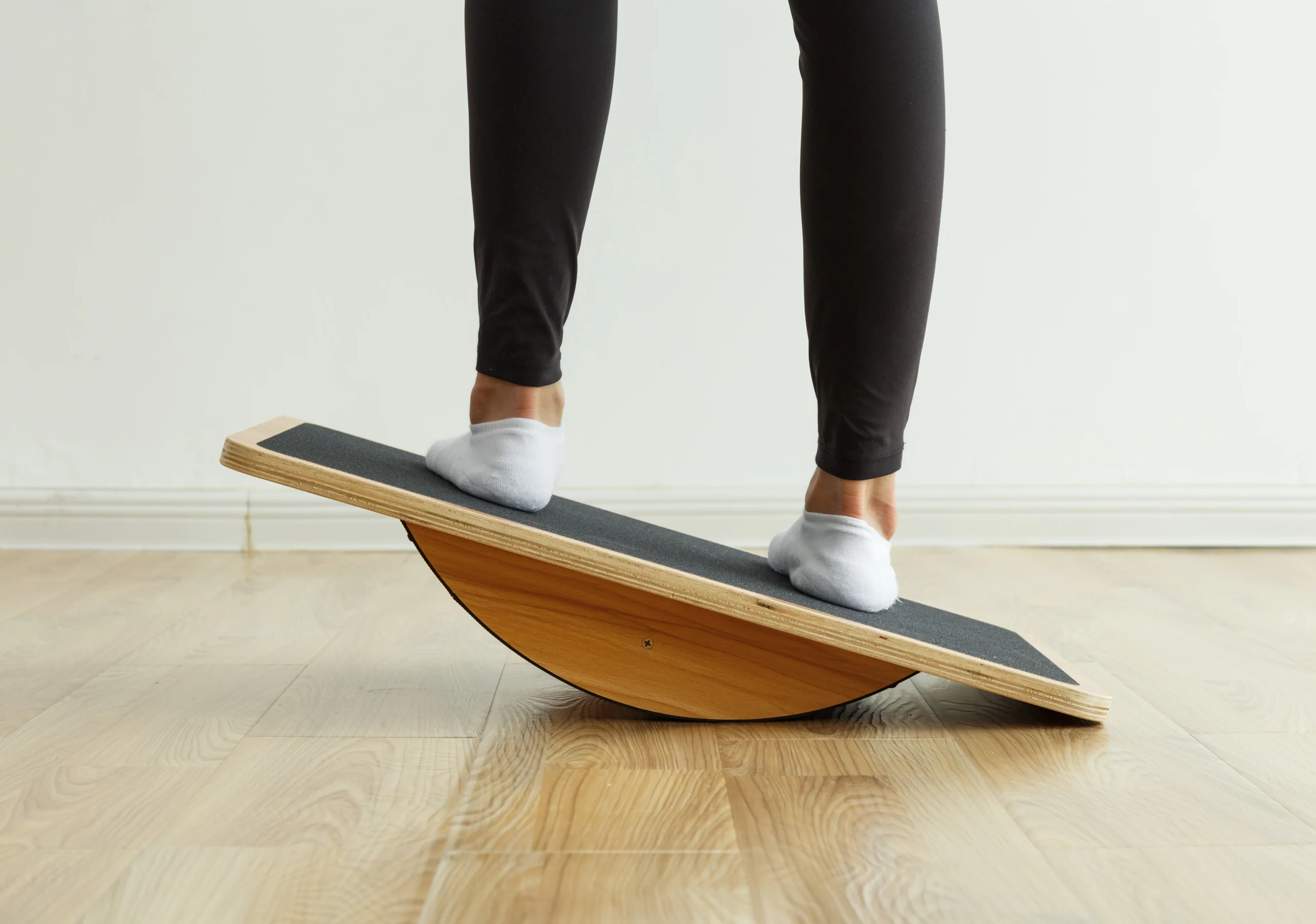johnbowe.info – Balance boards are versatile fitness tools that have gained significant popularity due to their effectiveness in improving balance, stability, and coordination. These boards come in various designs and sizes, but their primary function remains the same: to challenge the user’s balance by forcing them to stabilize their body while standing on a shifting or unstable surface. This article delves into the benefits, types, usage tips, and the science behind balance boards.
What Are Balance Boards?
A balance board, also known as a wobble board or stability board, is a piece of equipment used for training purposes to improve balance, coordination, and overall fitness. Typically, it consists of a flat platform placed on a rounded base or a half-sphere, creating an unstable surface. This instability forces the user to engage their core muscles and other stabilizer muscles to maintain balance.
Balance boards are often used by athletes to enhance their performance, as well as by individuals in rehabilitation to improve their motor control and prevent injury. They can be used in various exercises, from simple standing exercises to more advanced movements like squats, lunges, or push-ups.
The Evolution of Balance Boards
Balance boards have existed in some form for centuries. Early versions were used by indigenous cultures to develop physical prowess and balance for activities such as surfing, snowboarding, and other outdoor sports. The modern balance board, however, has become widely popular as part of a more structured fitness regimen. The use of balance training has become increasingly recognized in physical therapy, injury prevention, and overall fitness.
Benefits of Using a Balance Board
Balance boards provide a range of physical and mental benefits. They are not only useful for professional athletes but also for people seeking to enhance their everyday physical performance.
1. Improved Core Strength
The most prominent benefit of using a balance board is its ability to engage the core muscles. The instability of the board forces users to activate their abdominal muscles, lower back, and obliques to stay balanced. Over time, this leads to enhanced core strength, which is essential for overall fitness, posture, and injury prevention.
2. Enhanced Stability and Coordination
Balance training on a board improves your body’s ability to react to unstable situations. Whether it’s navigating uneven terrain or adjusting to sudden changes in posture, practicing on a balance board helps your body develop better coordination between the brain and muscles. This improvement in proprioception (awareness of body position) can translate into better performance in sports and day-to-day activities.
3. Rehabilitation and Injury Prevention
Balance boards are commonly used in physical therapy for rehabilitation after injuries, especially lower limb injuries like sprained ankles or knee injuries. The board helps patients regain their balance and stability while also strengthening muscles that may have weakened during the recovery process. Additionally, strengthening the muscles around the joints can reduce the likelihood of future injuries.
4. Boosted Flexibility and Mobility
While not the primary focus of balance boards, flexibility and mobility can be improved through consistent use. Certain exercises on the balance board, such as squats and lunges, can stretch and lengthen muscles, increasing joint mobility and muscle flexibility.
5. Mental Focus and Concentration
The challenge of maintaining balance requires concentration, focus, and mindfulness. Regularly using a balance board helps to improve mental clarity and the ability to focus, which can benefit other areas of life, such as work, study, or other physical activities.
Types of Balance Boards
Not all balance boards are created equal. Different types serve different needs, depending on the fitness goals, experience level, or rehabilitation requirements of the user.
1. Wobble Boards
Wobble boards are one of the most common types of balance boards. They consist of a flat surface with a rounded bottom, which allows the platform to tilt in all directions. This design makes wobble boards ideal for beginners and those looking to improve their overall balance. They are widely used for basic stability exercises and rehabilitation.
2. Roller Boards
Roller boards feature a flat platform that sits atop a cylindrical roller. This design is typically more challenging than the wobble board, as it requires the user to maintain balance while rolling the platform forward or backward. Roller boards are often used by more advanced users, such as surfers, skateboarders, or snowboarders, to simulate the movements and balance required in these sports.
3. Rocker Boards
Rocker boards are similar to wobble boards but with a flatter bottom, often curved slightly. They allow tilting in one direction (usually forward and backward). Rocker boards are frequently used in rehabilitation programs and by beginners, as they provide a more controlled and stable movement than wobble boards.
4. Balance Discs
Balance discs are inflatable, round cushions that can be placed on the floor or used in conjunction with a chair. They are often used for seated balance training or as a tool to enhance posture. By sitting on a balance disc, users engage their core muscles to maintain an upright position, which can improve core strength and balance over time.
How to Use a Balance Board
Using a balance board effectively requires some basic steps and guidelines to ensure safety and maximize its benefits.
1. Start Slowly
If you’re new to balance training, begin with a beginner-friendly board, such as a wobble board or rocker board. Start with simple exercises like standing on the board with both feet and holding the position for 30 seconds to a minute. Gradually increase the duration as your balance improves.
2. Focus on Form
It’s crucial to maintain proper form while using a balance board. Keep your knees slightly bent, engage your core, and maintain an upright posture. Avoid locking your knees, as this can strain your joints and reduce the effectiveness of the exercise.
3. Integrate Into Your Workout Routine
Balance training shouldn’t be limited to standing exercises. Once you feel confident, integrate the balance board into more dynamic movements such as lunges, squats, push-ups, or planks. These exercises provide a full-body workout while challenging your stability.
4. Include Short Sessions Daily
For the best results, include short balance board sessions into your daily routine. Ten to twenty minutes a day is often enough to experience improvements in balance and coordination.
Safety Tips for Using a Balance Board
While balance boards are generally safe, using them correctly is essential to avoid injury. Here are a few safety tips:
- Warm-up First: Always warm up before using a balance board to reduce the risk of muscle strains or sprains. Dynamic stretches or light cardio will prepare your muscles for the work ahead.
- Use a Soft Surface: Practice on a soft surface like a carpet or mat to cushion any falls. Hardwood floors or concrete can increase the risk of injury if you lose balance.
- Start with Support: If you’re a beginner, stand near a wall, countertop, or sturdy object to help you regain balance if necessary.
- Progress Gradually: Don’t rush into more complex exercises. Allow your body to adapt to the challenge and increase intensity as you become more comfortable.
Conclusion
Balance boards are fantastic tools for enhancing balance, coordination, and overall physical fitness. Whether you are an athlete looking to improve your performance, someone recovering from an injury, or simply trying to incorporate fun and effective training into your routine, balance boards offer a wide range of benefits. By selecting the right type of board and integrating balance training into your fitness regimen, you can significantly improve your posture, core strength, and even mental focus.
Make sure to start slow, practice proper form, and most importantly, have fun while using a balance board. As you grow stronger and more confident, you’ll be amazed at how much your balance improves, not just on the board, but in all areas of life.





